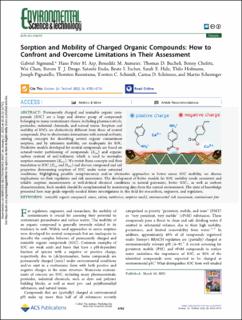| dc.contributor.author | Sigmund, Gabriel | |
| dc.contributor.author | Arp, Hans Peter | |
| dc.contributor.author | Aumeier, Benedikt M. | |
| dc.contributor.author | Bucheli, Thomas D. | |
| dc.contributor.author | Chefetz, Benny | |
| dc.contributor.author | Chen, Wei | |
| dc.contributor.author | Droge, Steven T. J. | |
| dc.contributor.author | Endo, Satoshi | |
| dc.contributor.author | Escher, Beate I. | |
| dc.contributor.author | Hale, Sarah | |
| dc.contributor.author | Hofmann, Thilo | |
| dc.contributor.author | Pignatello, Joseph | |
| dc.contributor.author | Reemtsma, Thorsten | |
| dc.contributor.author | Schmidt, Torsten C. | |
| dc.contributor.author | Schönsee, Carina D. | |
| dc.contributor.author | Scheringer, Martin | |
| dc.date.accessioned | 2023-02-22T10:22:32Z | |
| dc.date.available | 2023-02-22T10:22:32Z | |
| dc.date.created | 2022-04-24T13:59:38Z | |
| dc.date.issued | 2022 | |
| dc.identifier.citation | Environmental Science and Technology. 2022, 56 (8), 4702-4710. | en_US |
| dc.identifier.issn | 0013-936X | |
| dc.identifier.uri | https://hdl.handle.net/11250/3053142 | |
| dc.description.abstract | Permanently charged and ionizable organic compounds (IOC) are a large and diverse group of compounds belonging to many contaminant classes, including pharmaceuticals, pesticides, industrial chemicals, and natural toxins. Sorption and mobility of IOCs are distinctively different from those of neutral compounds. Due to electrostatic interactions with natural sorbents, existing concepts for describing neutral organic contaminant sorption, and by extension mobility, are inadequate for IOC. Predictive models developed for neutral compounds are based on octanol–water partitioning of compounds (Kow) and organic-carbon content of soil/sediment, which is used to normalize sorption measurements (KOC). We revisit those concepts and their translation to IOC (Dow and DOC) and discuss compound and soil properties determining sorption of IOC under water saturated conditions. Highlighting possible complementary and/or alternative approaches to better assess IOC mobility, we discuss implications on their regulation and risk assessment. The development of better models for IOC mobility needs consistent and reliable sorption measurements at well-defined chemical conditions in natural porewater, better IOC-, as well as sorbent characterization. Such models should be complemented by monitoring data from the natural environment. The state of knowledge presented here may guide urgently needed future investigations in this field for researchers, engineers, and regulators. | en_US |
| dc.language.iso | eng | en_US |
| dc.publisher | American Chemical Society | en_US |
| dc.rights | Navngivelse 4.0 Internasjonal | * |
| dc.rights.uri | http://creativecommons.org/licenses/by/4.0/deed.no | * |
| dc.title | Sorption and Mobility of Charged Organic Compounds: How to Confront and Overcome Limitations in Their Assessment | en_US |
| dc.title.alternative | Sorption and Mobility of Charged Organic Compounds: How to Confront and Overcome Limitations in Their Assessment | en_US |
| dc.type | Peer reviewed | en_US |
| dc.type | Journal article | en_US |
| dc.description.version | publishedVersion | en_US |
| dc.source.pagenumber | 4702-4710 | en_US |
| dc.source.volume | 56 | en_US |
| dc.source.journal | Environmental Science and Technology | en_US |
| dc.source.issue | 8 | en_US |
| dc.identifier.doi | 10.1021/acs.est.2c00570 | |
| dc.identifier.cristin | 2018670 | |
| cristin.ispublished | true | |
| cristin.fulltext | original | |
| cristin.qualitycode | 2 | |

